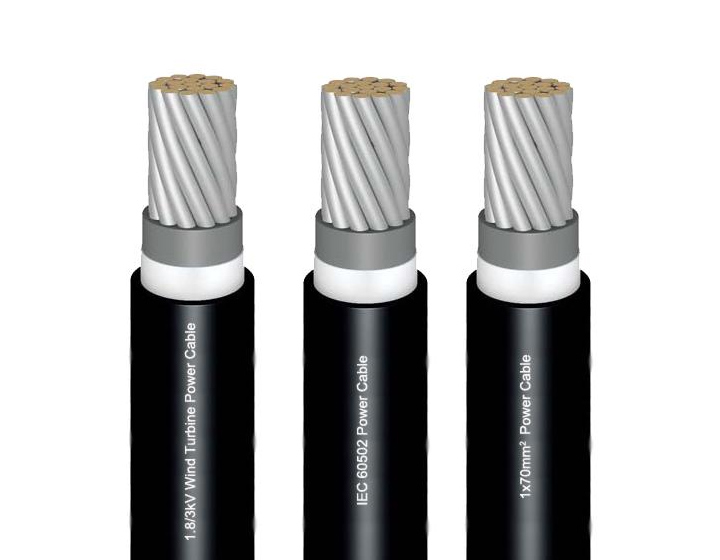
Product Overview
Application:
Specially engineered for high-torsion environments in wind turbines, these cables reliably transmit power from the nacelle-mounted generator to the base-located transformer. They endure dynamic stresses in free-hanging vertical tower installations, making them ideal for onshore/offshore wind farms.
Compliance:
Manufactured to IEC 60502 standards, ensuring global acceptance for medium-voltage power distribution in renewable energy infrastructure.
Construction & Material Properties
| Layer | Specification | Key Characteristics |
|---|---|---|
| Conductor | Tinned copper, Class 5/6 stranded (IEC 60228) | Superior flexibility, oxidation resistance. |
| Cross Section | 25–400 mm² | Optimized current capacity. |
| Insulation | EPR (Ethylene Propylene Rubber) | Thermal stability (–40°C to +125°C), UV/ozone resistance. |
| Sheath | HF XL EVA (Halogen-Free XL Ethylene Vinyl Acetate) | Flame-retardant, low smoke toxicity, abrasion-resistant. |
Technical Data
| Parameter | Value |
|---|---|
| Rated Voltage (Uo/U) | 1.8/3 kV |
| Test Voltage | 6.5 kV (AC, 5 min) |
| Operating Temperature | –40°C to +125°C |
| Torsional Endurance | ±15,000 cycles @ ±180º/m |
| Min. Bending Radius | 6 × Cable Diameter |
Product Specifications
For engineering selection and load calculations:
| Cross-Section (mm²) | Diameter (mm) | Copper Weight (kg/km) | Total Weight (kg/km) |
|---|---|---|---|
| 25 | 12.9 | 240 | 516 |
| 35 | 14.3 | 336 | 670 |
| 50 | 16.5 | 480 | 840 |
| 70 | 18.6 | 672 | 1112 |
| 95 | 21.6 | 912 | 1520 |
| 120 | 23.7 | 1152 | 1880 |
| 150 | 26.2 | 1440 | 2513 |
| 185 | 29.9 | 1776 | 3272 |
| 240 | 32.1 | 2304 | 3534 |
| 300 | 34.5 | 2880 | 4020 |
| 400 | 39.3 | 3840 | 5640 |
Key Engineering Features
-
Torsion Resilience:
Withstands ±15,000 twist cycles (±180º/m), ensuring longevity in turbulent wind conditions. -
Extreme Temperature Performance:
Operates in Arctic cold (–40°C) to desert heat (+125°C) without degradation. -
Safety Compliance:
Halogen-free sheath (HF XL EVA) reduces toxic fumes during fire incidents. -
Installation Flexibility:
Minimal bending radius (6× diameter) simplifies routing in confined tower spaces.
Application Scenarios
-
Vertical Power Transmission: Free-hanging deployments in wind turbine towers.
-
High-Vibration Zones: Nacelle-to-tower base connections in offshore turbines.
-
Renewable Energy Grids: Substation interconnections in wind farms.
